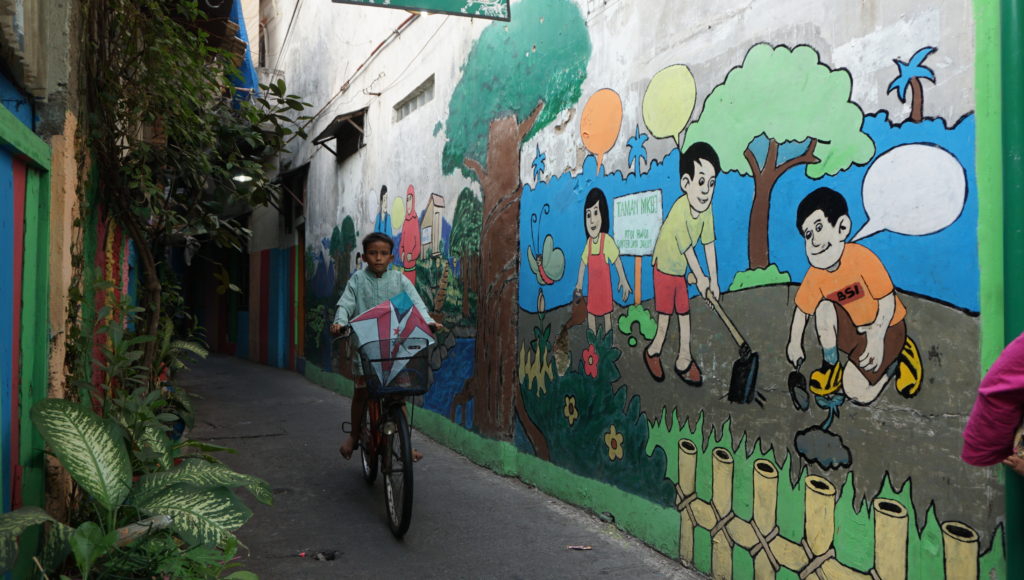
Sunter Jaya is one of over 2,500 kampungs, or urban villages, in Jakarta’s northern metropolitan area. Sunter Jaya is unique because it has developed in a way that features active pedestrian spaces and walkable streets; prime characteristics of Transit-Oriented Development (TOD). Building on the physical and community qualities of the kampung, ITDP recently spearheaded a pilot to improve accessibility and safety for pedestrians within the village. The pilot initiative received support from the local and provincial governments, and the methodology used will be a resource that can be replicated throughout 140 other kampungs in Jakarta.

What is a kampung?
Kampungs are organically established residential and mixed use inclusive communities that are often remnants of the original villages absorbed by the growing city. In most cases, they are considered legal settlements in local terms and provide housing for about 70-85% of Indonesia’s urban population. Kampungs are home to migrants and locals of various economic status and are economically self-sufficient thanks to their high mix of business and community-serving activities. The villages themselves are well-represented in local governance and comprise of the smallest administrative units. Urban villages boast high quality of life and diversity thanks to their good governance, civil participation, and transit-oriented neighborhood characteristics.

The goal of transit-oriented development is to create an environment in which people have easy access to quality transportation within their cities and communities. This is achieved through a variety of mechanisms. First, an environment must encompass a density of both people and activities that can support transport ridership. Second, walking and cycling conditions must be safe and capable of accessing transit stops and parts of the neighborhood. These features enable environments to decrease dependency on cars and reclaim street space for pedestrian activities. ITDP’s TOD framework defines the characteristics in 8 Principles: Walk, Cycle, Connect, Transit, Mix, Densify, Compact and Shift; all principles are needed to create equitable and inclusive neighborhoods.
Sunter Jaya is a unique kampung exemplifying quality urban conditions. Located at the bank of the Sunter Barat Reservoir within 1000 meters of a high capacity transit station, Sunter Jaya is home to about 13,000 people. The kampung developed organically in a manner that supports local activity and transport ridership making it an ideal starting place to improve existing systems. The village features a tight web of pedestrian and cycle networks and equitable access to a variety of services and opportunities. Good pedestrian and biking conditions make walking and cycling the preferred modes of transport for local residents to access neighborhood activities, especially for school children and their caregivers, many of whom are women. Narrow pedestrian shortcuts in the neighborhood prioritize pedestrian and cycle connectivity, making detours easier because longer blocks are cut into shorter segments that do not exceed 120 meters. These narrow, shaded streets discourage car access while many businesses and services have active frontages, creating an enclosed sense of community. It is estimated that 50 to 80% of housing is used for productive activities, making the mix of people, local jobs, and activities balanced and trips shorter. The housing density, and density of jobs and visitors are comparable to central areas, but the tightly knit low to medium rise buildings are unique in offering a built environment that feels human and able to sustain high-capacity transport services.
-

Pedestrians and cyclists easily navigate Sunter Jaya’s inner narrow streets -

Pedestrians and cyclists easily navigate Sunter Jaya’s inner narrow streets
Accessibility Improvement – Pilot Initiative
Building on local community strengths, ITDP recently performed an accessibility improvement pilot to raise awareness about community mobility and the value of the built environment characteristics that convey the essence of TOD.

While Sunter Jaya boasts a host of transit-oriented qualities, accessibility became a clear challenge when this pilot began. Because other modes like motorcycles, personal cars, low-capacity informal transport vehicles, and trucks increasingly compete for road space, pedestrians safety is constantly endangered, particularly on the main axes where heightened activities attract more car and foot traffic. Additionally, heavy traffic and unmarked crosswalks around the nearest Transjakarta Bus Rapid Transit service stop compromise access to high capacity transit. As a result, rather than using rapid transit, many people in the community prefer to use nearby low capacity transit instead like the Metromini bus service and informal transport.
Findings from Pilot
ITDP’s accessibility pilot initiative shed light on these issues by utilizing citizen participation and building on existing TOD-supportive urban form to transform this kampung into a fully accessible and safe community. Sunter Jaya’s pilot sought input from community groups, elevating the voices of women and school children who typically use non-motorized transport modes, on improvements in the village. The implementation phase included tactical strategies for improved safety and access for pedestrians, such as installing chicanes to slow traffic. Furthermore, surface delineation and use of greeneries within parking management were used to shift the space from cars to pedestrians. Street frontages were improved to engage children and people with art and games, complementing the neighborhood’s strong character. Lastly, the local government has committed to expanding the Transjakarta Bus Rapid Transit line to service the kampung, enabling access to destinations across the city and reducing traffic caused by personal vehicles and low-capacity transit modes.
The pilot’s success inspired the governor of Special Capital Region of Jakarta (DKI Jakarta) to invite all Jakarta city mayors to support the initiative and deploy it in over 140 other kampungs, engaging local communities and various grassroot groups. This great opportunity exemplifies how urban villages, and other areas alike can move towards sustainable urban form and equitable access.
Learn more about ITDP’s pilot initiative here.
Read more about this in Bahasa Indonesia here.
-

Examples of community participation and safety improvements. -

Examples of community participation and safety improvements.
Read and download ITDP Indonesia’s publication, Kampung Kota Bersama here.

